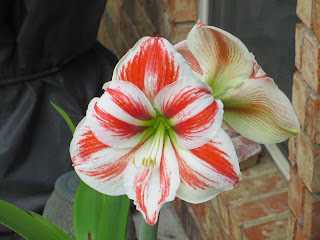Mean Old Lady
This is one Mean Old Lady!

Self-portrait: 'Quilter on Fire'
Monday, February 5, 2018
Our horse-loving daughter, Laura, created endless horse pictures, played with model horses, dreamed of someday owning a horse. That wish came true when she acquired a paint mare named Chloe; unfortunately, skittish Chloe spooked and threw Laura early last month--broken wrist, badly wrenched leg, bruises galore. During the time she spent with us, recuperating, she and I went through several storage boxes filled with childhood art and schoolwork done by Laura and brother Nathaniel.
This series of hand-drawn cartoon panels, entitled "Goof-Up," tells a story.....somewhat prescient!
"How pathetic," the horse thinks, as the happy-go-lucky person approaches.
A thundercloud conveys the horse's mood as the rider stands on the mounting block.
The horse acts!
Emotions are on display! The hapless rider lands in the stock tank while the horse celebrates.
The End!
Sunday, August 6, 2017
Our Health Insurance Story (aka "Long Time, No See!")
I spent a good bit of time writing this after getting an initial blow-off letter from our Congressional Representative, French Hill. They sent me a link to House Speaker Paul Ryan's BS 'Better Way' and also a link to the Republican Study Committee (chaired by Walker) which is a conservative caucus in the House. (Actually, the initial response had links that didn't work. After two pokes from me, I got working links from their deputy chief of staff in DC.) The RSC section on health care made my blood run cold. It includes high risk pools...and states that "Health care is not a right; it is a service."
This is my rebuttal (for what it's worth...)
No response.
I know this is long, but I hope you will be interested in our story enough to persist.
To: Rep. French Hill
Subject: Re: health insurance
Dear Representative:
or more accurately, Dear Staffer who is actually reading this:
My husband and I would ask that you read this and perhaps bring it to the attention of your boss. We studied the links provided (thank you, Peter Comstock) carefully. 'A Better Way' is merely an outline without any substantive fleshing out in details. The RSC document, however, is much meatier--and we found many facets of the Health Care section concerning.
I believe that we can offer a unique perspective after more than 35 years spent as consumers/subscribers of the US health insurance industry while trying to obtain care (and coverage) for a child with a congenital heart defect, a crippling surgical complication, and an array of chronic health impairments .
In 1980, when our first child was born, my husband and I were covered by my health insurance policy with the school district where I was a special education teacher. Because of the severity of our child's problems, I did not return to work as planned, but instead exhausted the considerable sick leave days I had accumulated. When it became clear that I would have to resign my teaching position, my husband closed his small consulting business and sought employment with a larger firm that would offer benefits.
I would like to share thumbnail sketches of the experiences we had over the years, in five different states, through various changes and reforms, as a family seriously impacted by the complexities of our patchwork system. We were on an anvil where the hammer most heavily struck.
* There was no 'national coverage.' Even if a major insurer was represented in every state, the coverage, costs, and benefit details varied from state to state. In one case, a major insurer withdrew all policies from our state. (Only the New York State Insurance Commissioner protected his state's enrollees by forbidding this action; our state--Arkansas-- was not so fortunate.)
* HMO: After a relocation, this was the only option for us until the next Open Enrollment period (after my gestation was complete and our second child was born.) In theory our older, disabled child could be approved for services, procedures, or specialist care that the HMO did not provide, but the financial incentive was strong for the HMO to deny such referrals. We were told our daughter could see 'an HMO orthopedist,' but he was neither Board-certified nor a pediatric specialist. We exited the HMO at our earliest opportunity.
* Pre-existing conditions: waiting periods ranged from 18 months to 2 years. At one point we carried our old policy alongside the new insurance until the waiting period could be satisfied. Fairly costly. My husband turned down some attractive job offers because we were geographical hostages, afraid to change insurers.
* Claims: Until electronic filing became widespread, I spent many hours each week filing insurance claims, copying paperwork, telephoning to correct errors, and appealing denials. It was routine to find that a large claim would be denied immediately; only if I persisted would the claim be reviewed and finally paid. BCBS of Ohio was found to be paying lower negotiated rates to hospitals and clinics, while figuring co-pay amounts for patients on the full charge shown on the bill. I found myself acting as the (unpaid) clerk handling our many mismanaged claims.
Even though electronic filing has eased some aspects of the claims process, prescribing, and reporting, it is not without problems. A mistaken keystroke has more than once resulted in an incorrect prescription dosage--fortunately caught by an alert pharmacist--or erroneous quantities. Because we no longer see the billing details, errors and oversights can occur; this is an invitation to fraud. (In the past, hospitals found that having a patient review a paper bill resulted in significant savings. Mistakes happen.)
* Association plans: Thanks to my writing (one of the few occupations compatible with my stay-at-home status) I was able to join the National Writers' Union, which offered insurance to members through an affiliation with the UAW. Unfortunately, our rates were negotiated separately, so we had few protections. We experienced several changes of insurers. (The advantage to us, personally, was that my husband was able to form his own small business again. Until that time, we were hostage to our need for family coverage through his employment.)
The major insurance companies began backing away from 'association plans,' finding them inconvenient and citing rising costs. The NWU policy changed carriers several times--and by 2002 we were paying $1200 per month for family coverage. Ultimately, the NWU was signed up with Employers Mutual--which entity turned out to be a scam. (Peter Jennings of ABC News reported on this in the early 2000's.) We had paid thousands in premiums; no claims were satisfied until 10 years after the court-ordered process under a fiduciary agent. Many victims died before they could be made whole financially.
Individual health plans: There is no 'guaranteed issue' with such plans. When the NWU could no longer offer insurance, we applied for a family policy and quickly found that not only was our daughter excluded--multiple chronic illnesses, a mobility disorder-- but also my husband--with sleep apnea and 100% compliant with C-PAP use-- was excluded as well. They were uninsurable at any price.
* Employer-based insurance: With the collapse of the NWU insurance plans, and given our inability to get an individual policy, I returned to the workforce, taking a job-share teaching position at a children's residential rehab facility. Part-time work did not offer insurance benefits unless the individual (myself) was willing to pay the full family-coverage premium. The premiums were high, so I was basically working for insurance. (It has become quite common for employers to split full-time positions, offering instead two part-time slots. It saves money for the employer--but for the worker, not so much, even with the ACA.)
*COBRA: This welcome reform was helpful when our daughter graduated from college; she was able to continue with that insurance for the mandated three years. At the end of that period, she was still in graduate school, and her only option was to seek an individual plan-- but she was still uninsurable at any price.
* High Risk Pool: Our daughter was able to show continuous coverage for a period of three + years, and it took about 10 seconds for her to obtain a Denial of Coverage from an insurer. She entered the High Risk Pool in the State of Arkansas. The problem, of course, is that these are a bad idea that doesn't work. All the 'bad eggs'in one basket' means that costs spiral ever upward, while the minimal coverage continued to erode. Enrollees were uncooperative, failing to die in suitable numbers. What makes insurance work well is spreading the risk over a large group; ALL of us, together, can take care of EACH of us. Creating innumerable separate pools encourages cherry-picking and excessive premium increases when a member of a particular pool happens to fall seriously ill. We've already lived through that scenario! It's one of the problems that led most modern, industrialized nations to adopt universal single-payer health care insurance decades ago, with the exception, of course, of the USA and South Africa. Some issues require the might and resources of the country's government in reaching a solution.
* The ACA, aka Obamacare: By the time this reform emerged from the fray, many protections had been stripped away and common-sense steps like negotiated drug pricing had been left by the wayside. Instead of tossing away the progress that HAS been made, our legislative bodies should put sensible pricing limits in place. Insurers and practitioners will still make profits. (I would point out that private insurers thrive even in countries with single-payer systems.)
Before the ACA was passed, my husband and I had entered Medicare--the best insurance we've EVER had. Operating on only 3% of its budget, Medicare handles our claims seamlessly, promptly, and correctly. We go to 'any willing provider.' We carry separate supplemental insurance and a drug policy, along with vision and dental coverage. Our children--educated, employed, and independent-- are covered by their own policies. (Our daughter, a Federal employee, has excellent coverage; she will have to see specialists as long as she lives. Our son, working for a large corporation, has insurance he calls 'wonderful.' When his fiancee suffered a stroke, it could have meant financial devastation--but it didn't.)
Although the ACA came about only after we were unable to benefit from it, we celebrate this legislation. We know that many Arkansans have found it a life-saver--at times, literally. Small business folk, craftsmen, and artists can obtain coverage. People who had put off medical care for years have been able to see physicians and surgeons. The response seems to have surprised planners--some caregivers have been overwhelmed. Arkansas is a poor state with a population that ranks low in health status. Smoking; obesity; poor hygiene and basic care; diabetes; skin cancers; pesticide exposure--all of these contribute. Life spans are shorter here.
We've seen urgent care and walk-in clinics burgeoning; the ER is no longer the only place to go. A new hospital was just built in Conway. In a state where access to healthcare is often difficult, we need more, not fewer, facilities.
I hope that you believe our government programs and policies should not be dictated by insurance companies and drug manufacturers. You are there to protect and defend people, not corporations. The proposals of the RSC represent a return to many of the failed practices that made our lives (and our finances) problematic for decades.
The nominee for head of HHS, Tom Price, does not have the perspective that I have offered for your consideration. Each Legislator is in a position to roll back real progress and return to discredited practices that burden families like ours......or, perhaps instead to seek bipartisan cooperation that improves on the partially-successful ACA.
Very truly yours,
Crosswords!
I'm publishing this belatedly--somehow overlooked it, as I haven't been blogging regularly. That rascally FaceBook gets more than its fair share of attention!
Wes Lacewell and Beth Levi Win 2017 Arkansas Crossword Puzzle and Sudoku Championships
Wes Lacewell of Little Rock, a manager with the Division of Building Authority at the Arkansas Department of Finance and Administration, won the 10th annual Arkansas State Crossword Puzzle Championship Sunday afternoon at the University of Arkansas Clinton School of Public Service. It was his third title having won previously in 2008 and 2009. Beth Levi, a clinical professor at the UALR William H. Bowen School of Law, won the Sudoku competition for the eighth time. She also won in 2015 and 2016.
Retired Judge and Clinton Center volunteer Ellen Brantley was second in the crossword contest. Brantley is a two-time winner and this year marks her fourth time to finish second. Angelo Turturro, who is retired and lives in North Little Rock, was third.
Little Rock ophthalmologist Jim Deer finished second in the Sudoku competition. Robert Crook, senior database administrator with Talisys, a software and solutions firm in Little Rock, was third.
The championships were conducted by Little Rock District Judge Vic Fleming who constructs puzzles for the New York Times and other major publications. Deb Amlen, editor of the Wordplay crossword column in the New York Times, was the featured speaker.
The Clinton School has hosted the competition since its founding in 2007.
***********
My friend Glenn and I have participated in this contest several times, and Glenn has been a first-place winner! This year's event was part of the Arkansas Literary Festival and took place at Sturgis Hall, part of The Clinton Presidential Library Center. A big storm the night before had knocked out the power to the building, and a very loud alarm was going off continuously. The fire department finally got the darned thing turned down to a constant, faint beep beep that continued throughout the contest rounds. A warm-up activity--matching puzzle quotes to famous names--was won by "The Three Wise Women"--a trio that included Glenn and myself. I was fourth or fifth place in the crossword line-up, but there were so many puzzle books donated for prizes that I came home with two!
Yay, puzzles!
"Big Bang Theory"
This is my most recent quilt--entered in the Hot Springs Quilt Show 2017.
Each entry was required to include a brief description of the quilt, its inspiration, and so forth. Here is what I wrote:
I began making these English paper-pieced stars more than 12 years ago, as a fairly inexperienced quilter. (I progressed from hand-traced freezer-paper construction to computer-printed freezer paper to die-cut paper pieces from a commercial vendor; there were some sizing differences....) For me it was a way to try a new technique and use small amounts of exciting fabrics like batiks.
My design ideas going into the project were fuzzy "maybes," but as time passed ...and passed...our exploratory probes traveled into space to visit distant planets and the Hubble telescope sent amazing images of distant nebuli. I became interested in representing Outer Space in fabric, using my stars to illustrate "The Big Bang Theory."
I went through a number of possible arrangements. Then I had to construct all of the (English paper-pieced) background for the stars and come up with a way to join all of this into a quilt top using my machine (or else plan for it to take a century.)
Can you find the Black Hole and the Star that has 'gone out'?
Friday, September 4, 2015
Recent works
I have been blogging less and quilting more--not least because I need to complete many projects that have languished for too long. A recent NQA show in Little Rock spurred me on; I entered three pieces--

This is 'Rooster and Plaids,' and I gave up about 50 squares from a quilt I had planned and worked on for more than a year....simply because I pinned the central medallion up on the wall right over the plaid blocks--and loved the look!
This one is a take-off
on a Gauguin Tahitian landscape....made in response to a challenge ('landscape with a tree and a bird') and quite the learning experience to create. Took me way longer than I had planned/hoped/expected.
This one might look a little nutty. Each square was appliqued with a small heart shape over the course of, well, about 12 years of PTA meetings. The fabrics were from clothes I made daughter Laura, a maternity dress, my first quilt, and God only knows where else. They didn't 'belong' together, there was no master plan, and I was in despair of ever making them work together.....and then Sharyn Craig came to our guild in Little Rock and opened my eyes! This setting is called 'Twist and Turn,' and it made the blocks dance and work together. It's far from a perfect quilt, but it's priceless!
None of these quilts garnered any recognition, but I hope that people enjoyed seeing them.
My criterion for a successful quilt is this: does it make me smile?
These do.

This is 'Rooster and Plaids,' and I gave up about 50 squares from a quilt I had planned and worked on for more than a year....simply because I pinned the central medallion up on the wall right over the plaid blocks--and loved the look!
This one is a take-off
on a Gauguin Tahitian landscape....made in response to a challenge ('landscape with a tree and a bird') and quite the learning experience to create. Took me way longer than I had planned/hoped/expected.
This one might look a little nutty. Each square was appliqued with a small heart shape over the course of, well, about 12 years of PTA meetings. The fabrics were from clothes I made daughter Laura, a maternity dress, my first quilt, and God only knows where else. They didn't 'belong' together, there was no master plan, and I was in despair of ever making them work together.....and then Sharyn Craig came to our guild in Little Rock and opened my eyes! This setting is called 'Twist and Turn,' and it made the blocks dance and work together. It's far from a perfect quilt, but it's priceless!
None of these quilts garnered any recognition, but I hope that people enjoyed seeing them.
My criterion for a successful quilt is this: does it make me smile?
These do.
Wednesday, June 3, 2015
Fame and Fortune Await....?
Good afternoon Elaine!
I'm writing an article for the Loudoun County Virginia Master Gardener newsletter about asparagus and would like to use a photograph you have on your blog in illustrating the article. I've inserted the photo below so you can see which one I'd like to use, as an example of a healthy, weed-free asparagus bed in a home garden.
I would greatly appreciate it if you would give me permission to use the photograph. If you do, the credit line would read Photo courtesy of Elaine Walizer at http://elaineinarkansas.blogspot.com
Thanks so much!
So, some gardeners in Virginia will be viewing my asparagus patch (post-cutting, when the sprouts were ferned out and manure had been applied.) Of course I was happy to grant permission. Isn't the Internet amazing?
 |
| This is a different photo--it's Spring, 2015...I had just weeded and set up the soaker hoses (which have been largely superfluous in our wet, wet weather. |
Wednesday, May 20, 2015
April Showers bring May Showers....
Our chilly wet Spring has continued. I put my long-sleeved tops and sweaters away only to bring them back out for our trip to Fayetteville (the DHubby's 74th birthday) and subsequent weeks back home. Every once in a while we have a dry, sunny day, but then another front moves through.... The yard couldn't be mowed for an entire month (March 31st to April 30th) and was quite jungle-like. I began referring to one area as 'the water-meadow.' I was wading out to cut asparagus daily.
But I must say, the plantings have been quite enthusiastic! The irises were followed by the roses:
'Crepuscular' has dawn colors; 'New Dawn' is pale pink; and 'Little Pinkie' is a brighter pink.
These amaryllis over-Winter in the garage and then begin coming back to life in February. The darker red one had four blooms and the striped one just these two.
The pomegranate never bears fruit, but the bright orange blooms are striking and attractive. These probably did better before the live oak on the side of the house got so large. The shade was deep, but improved when we had some limbs cut back.
The elderberries in the yard are all 'volunteers' sowed by the birds. In Ohio they grew to about 6' at best; these are 9-12 feet tall. Last year I did not cut off the heads and I had tons of berries, so I made jelly. This year I will try to give them away or something...the flowers are so fragrant, and when they fall from the bloomheads it looks like tiny stars are scattered on the brick walkway.
During the 90's the DHubby and I made a couple of trips to upper NY state--a lovely area!--and at a barn sale in Brockton I admired a garden in the yard. The little old lady gave me a spadeful of this plant--saying she did not know the name--and I kept it going all week until I could get home and plant it in our yard there in Ohio. I've shared starts with neighbors all over, and I brought some with me to Arkansas. I have it in several beds now, and I love that it has spread. Every year the bright yellow is a joy to see.
The big hosta has two bloom-stalks coming up; the mint (you can see it in the close-up above) is of course everywhere, and the violets are finished seeding. Now it's just a matter of weeding the trumpet vines out and keeping my eye out for poison ivy...
We have had *some* warm days, and a few dry ones, but the copious rain continues this week. I begin to think we need an Ark!
But I must say, the plantings have been quite enthusiastic! The irises were followed by the roses:
'Crepuscular' has dawn colors; 'New Dawn' is pale pink; and 'Little Pinkie' is a brighter pink.
These amaryllis over-Winter in the garage and then begin coming back to life in February. The darker red one had four blooms and the striped one just these two.
The pomegranate never bears fruit, but the bright orange blooms are striking and attractive. These probably did better before the live oak on the side of the house got so large. The shade was deep, but improved when we had some limbs cut back.
The elderberries in the yard are all 'volunteers' sowed by the birds. In Ohio they grew to about 6' at best; these are 9-12 feet tall. Last year I did not cut off the heads and I had tons of berries, so I made jelly. This year I will try to give them away or something...the flowers are so fragrant, and when they fall from the bloomheads it looks like tiny stars are scattered on the brick walkway.
During the 90's the DHubby and I made a couple of trips to upper NY state--a lovely area!--and at a barn sale in Brockton I admired a garden in the yard. The little old lady gave me a spadeful of this plant--saying she did not know the name--and I kept it going all week until I could get home and plant it in our yard there in Ohio. I've shared starts with neighbors all over, and I brought some with me to Arkansas. I have it in several beds now, and I love that it has spread. Every year the bright yellow is a joy to see.
The big hosta has two bloom-stalks coming up; the mint (you can see it in the close-up above) is of course everywhere, and the violets are finished seeding. Now it's just a matter of weeding the trumpet vines out and keeping my eye out for poison ivy...
We have had *some* warm days, and a few dry ones, but the copious rain continues this week. I begin to think we need an Ark!
Subscribe to:
Comments (Atom)

Rose 'Crepuscular'

Asparagus bed--post harvest

Lake Conway Mutti und Kinder
















